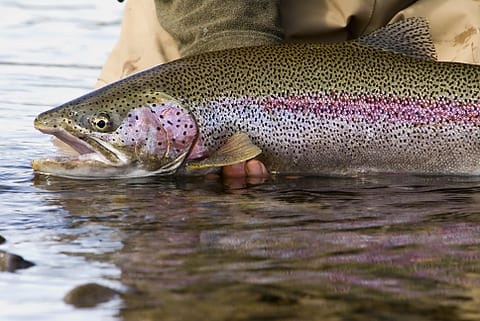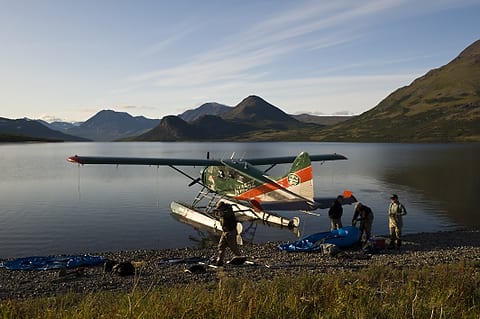 Thousands of miles north of Texas, a sinister threat to all sportsmen and conservationists continues to raise its ugly head.
Thousands of miles north of Texas, a sinister threat to all sportsmen and conservationists continues to raise its ugly head.
The threat is the proposed Pebble Mine built in the Bristol Bay area of Alaska, a 40,000 square mile wetland with nine major river watersheds, and home to some of the best wild sockeye salmon and trout fishing in the world. The mine has the potential to dump billions of tons of perpetually toxic waste into this fragile Bristol Bay watershed, threatening the region’s ecosystem forever.
In 2010, Alaska natives, the commercial fishing industry, sport fishing and hunting interests, and the tourism industry in Alaska asked the Environmental Protection Agency to conduct a scientific assessment study in the area. The EPA agreed, and will release its findings in the coming days. This is a great first step toward protecting the Bristol Bay watershed and its salmon population, the source of a $450 million commercial fishing industry, spectacular sport fishing, and the Alaska Native way of life.
Last month, representing the Dallas Safari Club, I joined over 40 other sportsmen from across the country in Washington, DC to advocate for protecting Bristol Bay. We met with Members of Congress, the Administration, and EPA officials including Administrator Lisa Jackson. Rarely has such a large and diverse group come together on a singular issue, but support for Bristol Bay cuts across geography, ideology, and socioeconomic status. The folks gathered in Washington were testament to the importance of Bristol Bay to the United States, and we found an audience receptive to our concerns.
This is an important issue in the Lone Star State as well, as thousands of Texans each year journey to this area of Alaska to enjoy the fabulous fishing, yours truly among them. Over the past seven years I have floated, fished, and camped on eight different rivers in the Bristol Bay watershed and have marveled each time at the phenomenal salmon migration. I have seen the bears, wolves, eagles and other wildlife dependant on the salmon for life itself. I have caught and released hundreds of salmon as well as untold numbers of rainbow trout and dolly varden, which gorge themselves on the salmon eggs used in the spawning cycle. To see thousands of salmon all headed up these pure, unspoiled waterways to the place they themselves were spawned in order to complete their life cycle is an experience I wish all could behold.
The Dallas Safari Club and its charitable arm, the Dallas Ecological Foundation, both of which I have served as president, have contributed tens of thousands of dollars to support wildlife and conservation and to secure hunting and fishing access in Southwest Alaska. To imagine that this could be lost due to man’s greed and carelessness is incomprehensible to me, but this could be the case if the Pebble Mine is allowed to proceed.
Not only would a 20 square mile area be gouged as a part of the mining operation, but the two foreign companies proposing the mine will build one of the world’s largest earthen dams to contain the toxic waste used in the separation process. This is proposed in an area with known volcanic and earthquake activity. How much would it take to ruin the integrity of this earthen dam and send this toxic waste pouring down the rivers and creeks of this pristine area? How much risk are we as Americans willing to take with one of our last true wilderness areas? This is not just an Alaskan decision, but one of concern to all Americans and is a risk too great to allow as a nation. If a mistake occurred, repair would be impossible. There is simply too much at risk in this natural wilderness.
 In most areas, salmon and their habitat have largely disappeared, traded in the name of progress and development. Perhaps this is our chance to save the last great fishery — one that is an economic engine for an entire regional economy, representing $500 million in annual revenue and supporting over 12,000 jobs. While we can’t undo past disasters, we can prevent this one. The EPA’s scientific review is a substantial first step to protect Bristol Bay, but the agency must also act once the science backs up our concerns about the Pebble mine and Bristol Bay. We as conservationists urge the EPA to invoke section 404(C) of the Clean Water Act to protect Bristol Bay. You can contact the EPA and ask them to take action at www.savebristolbay.org/takeaction
In most areas, salmon and their habitat have largely disappeared, traded in the name of progress and development. Perhaps this is our chance to save the last great fishery — one that is an economic engine for an entire regional economy, representing $500 million in annual revenue and supporting over 12,000 jobs. While we can’t undo past disasters, we can prevent this one. The EPA’s scientific review is a substantial first step to protect Bristol Bay, but the agency must also act once the science backs up our concerns about the Pebble mine and Bristol Bay. We as conservationists urge the EPA to invoke section 404(C) of the Clean Water Act to protect Bristol Bay. You can contact the EPA and ask them to take action at www.savebristolbay.org/takeaction
Dr. Richard Allen is a retired dentist who practiced in Carrollton, TX for 35 years. He currently lives on a ranch near Kerrville and is the director of marketing and director of the Youth Outdoor Adventure Program at Joshua Creek Ranch near Boerne. He has served as President of the Dallas Safari Club as well as chairman of the annual convention on four occasions and as chairman of the Dallas Ecological Foundation. He is an avid fisherman and hunter and a dedicated conservationist.

